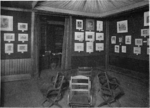House at 12–16 Corey Road
Houses completed in 1896Houses in Brookline, MassachusettsHouses on the National Register of Historic Places in Norfolk County, MassachusettsNational Register of Historic Places in Brookline, MassachusettsNorfolk County, Massachusetts Registered Historic Place stubs

The House at 12–16 Corey Road in Brookline, Massachusetts is a distinctive local example of townhouses in an English Revival style with Shingle elements. The townhouses were designed by Arthur H. Bowdith, a prominent local architect, and built in 1896 for Alan Arthur and Gardiner Shaw, two real estate agents. The townhouses have steeply-pitched shingled gables, projecting diamond-pane windows, and bracketed bargeboard trim.The houses were listed on the National Register of Historic Places in 1985.
Excerpt from the Wikipedia article House at 12–16 Corey Road (License: CC BY-SA 3.0, Authors, Images).House at 12–16 Corey Road
Beacon Street,
Geographical coordinates (GPS) Address Nearby Places Show on map
Geographical coordinates (GPS)
| Latitude | Longitude |
|---|---|
| N 42.338055555556 ° | E -71.143055555556 ° |
Address
Beacon Street 1788
02447
Massachusetts, United States
Open on Google Maps










